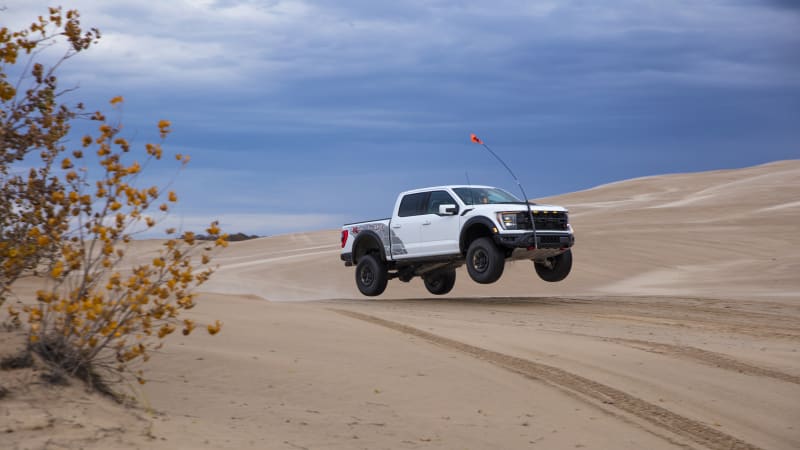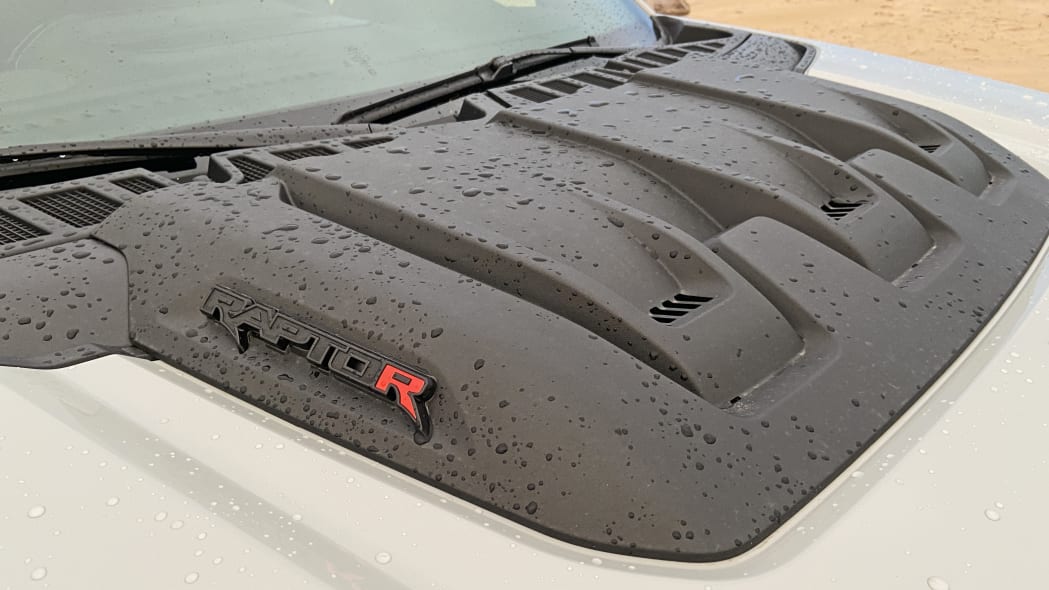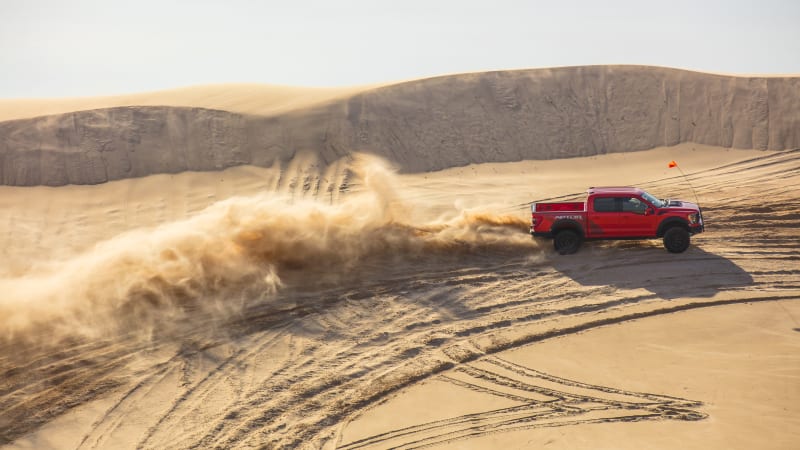2023 Ford F-150 Raptor R First Drive Review: The 'Big Raptor' gets the big V8

Up until very recently, there was only one Ford Raptor — no Ranger, no Bronco, just the F-150, or as its engineering team likes to call it, “Big Raptor.” The OG. The king. In Big Raptor’s little corner of the Ford Performance world, bringing the V8 back was always a matter of when, not if. But the realities of the market held sway and other projects took priority — including an overhaul of the truck’s suspension. Then TRX happened.
For quite a while, Raptor effectively had no competitors. We need look no further than the Stellantis lineup to see what being alone in the market does to innovation: the Bronco has clearly awoken Jeep from a similar torpor. As the old saying goes, competition betters the breed. In plain terms, we now have an alternative to the 702-horsepower supercharged Ram in the form of a 700-horsepower, also-supercharged F-150. What a world.
Unlike TRX, though, the 2023 Ford Raptor R had the benefit of an existing framework. Oftentimes it’s dismissive to describe a performance variant as merely the base vehicle with a bigger engine, but in this case it’s the literal truth. Apart from some visual details and swapping a few suspension components to account for the weight of the V8, the Raptor R really is just a more powerful Raptor with the 37-inch tire option made standard. Specifically, adding the GT500’s 5.2-liter supercharged V8 pumps things up to 700 hp and 640 pound-feet of torque from 450 hp and 510 lb-ft with the 3.5-liter turbo V6.
The stiffer springs keep the ground clearance identical to a V6 Raptor with 37s (13.1 inches), and the same goes for all the other vital off-road specs. Approach, breakover and departure angles remain at 33.1, 24.9 and 24.4 degrees, respectively, and the R offers the same amount of suspension travel (13 inches up front and 14.1 in the rear).
The Raptor’s engineers tinkered with the drive modes a bit for R, changing the default Sport Mode powertrain setup to be the automatic 4WD setting (it’s 2WD in the standard Raptor) in order to put all that power to good use. The standard 37s on the Raptor R don’t do the truck any favors off the line, and in fact may keep a drag race between the R and the TRX perilously close, but the V8 can still rip that off-road rubber to shreds if that’s what you’re going for. We were only given the opportunity to practice acceleration runs on sand — useless for data gathering, but immensely fun.
The differentiation is minimal in practice, too. Setting aside the Raptor R’s dramatic acceleration, the drive is virtually identical. That’s a good thing, and due at least in part to the fact that minimal alterations translate to minimal weight gain. The R weighs roughly 5,950 pounds — about 100 pounds more than a V6 Raptor with the 37s (or 200 pounds more than without). Yeah, that’s a hefty curb weight, but remember that the iron-block Hellcat V8 in the TRX helps push that all-steel truck north of 6,350 pounds. The Raptor’s comparatively lightweight aluminum body gives it a pretty serious edge.

The Raptor never truly feels small, but Ford’s efforts to control the R’s diet bore fruit. Plodding around town, the R doesn’t really feel that different from a Coyote-equipped F-150 unless you start exploring the lower 2/3 of the throttle’s travel, which results in wonderful noises and rapid fuel consumption. The official EPA estimate stands at 15 mpg combined, which may smoke the TRX’s 12 mpg combined, but a couple hours spent shuttling to and from Michigan’s Silver Lake Sand Dunes resulted in averages between 10 and 12 mpg for our caravan of a dozen trucks. Maybe the TRX would’ve performed better versus its estimates in the same driving, maybe it would’ve been in the single digits, but either way, our experience with the Raptor R in the sand was even more petroleum-dependent.
Not that we really paid attention to fuel consumption while blasting around Silver Lake. The park’s enormous dunes and generous (read: barely there) restrictions make it a perfect four-wheel playground. With the exception of its heavily trafficked transit roads, it has no speed limits. Instead, it’s arranged in a giant, one-way loop designed to keep everybody pointed in roughly the same direction, limiting the potential for catastrophic encounters over blind crests — of which there are a great many.
And Ford let us do it all, from dune climbs to drag racing and everything else in between. It was easy to lose track of how many times the trucks visibly caught air long before most of America was done making morning coffee. “It’ll do that all day long” was the constant refrain from Ford’s engineers and test drivers. And they were proven right. Neither the supercharged V8 nor the brakes showed any signs of giving up, despite the fish market funk of hot friction surfaces that wafted along in our wake. That traction control system has its hands full on a surface like this, but man, the brakes grab those 37s hard even on loose sand. This thing is no joke.

The secret to a truly great supertruck is in the suspension. For off-roading, a delicate balance must be struck between travel, comfort and control — not your ability to point the truck where you want it to go, mind you, but control over the truck’s body motions, especially the vertical jacking that comes with traveling fast over rutted and washboarded surfaces.
If your shocks are too firm, they’ll yank the truck down after every bump, resulting in a paint shaker sort of ride. Too soft and it won’t settle, leaving you in a constant state of slow undulation that robs you of grip and invites you to spend a lot of time riding around on the suspension’s bump stops. That’s how shocks get blown out and control arms get bent and broken, or worse, you land the truck’s soft belly on a not-so-soft rock and puncture something critical, like the 5.2-liter’s oil pan, for instance.
Ford’s five-link, coil-sprung rear suspension works absolute wonders both on- and off-road. As hard-nosed as the Raptor is, it’s an absolute kitten to cruise around in, even on crappy surfaces. The rear suspension is a dream, making the Raptor feel more SUV-like than truck-like on asphalt. But while it drives small, it’s inescapably large — and by that I mean wide. And that’s exacerbated by the fact that the R drives so tight in spite of its size and substance. It doesn’t feel like a car you need to thread carefully through construction zones, but its width will catch you out if you’re not careful. I got more hits from the R’s lane-departure warning than I ever have driving a Super Duty. Keeping it between the lines is more challenging than sticking the landing after yeeting it off a sand dune, I kid you not.

And then there’s the cabin. Like the exterior, it’s mostly carry-over. Unless you can guarantee an allocation and special-order a Raptor R, chances are the only way you’ll ever see one is loaded, because Ford says that’s how the dealers are requesting them. Despite this, it’s still a half-step behind the Ram in terms of materials and design. The upgraded seats are nothing like the sculpted buckets found in a Mustang Mach 1 or GT500, but they’re supportive and comfortable enough for the things you’d expect an F-150 to do — even this one.
The Raptor occupies a lonely corner of the pickup landscape. For a long time, it was the only full-size pickup trying to play in the Baja enthusiast space. It’s a niche Ford carved out for itself more than a decade ago. While Ram was the first to escalate the supertruck wars to their contemporary levels of absurdity, this really feels like Ford’s fight to lose. It has the tighter, lighter, more-focused truck, but it also has the most likely alternative purchase in the standard Raptor. Both are very good at what they do. In fact, I can’t help but think of Cadillac’s Blackwings; the best argument against purchasing either is that the other one exists.
The Raptor R is everything it appears to be. It’s big, boisterous and willing — every bit the equal (at minimum) of Ram’s Hellcat-powered TRX. The V8 is straight-up nasty, with an off-road exhaust mode that will liquefy children’s ear drums. It’ll do everything the V6 Raptor does just a little bit quicker and with a whole lot more fanfare. If that’s ticking your boxes, then you’re in business. Hopefully business is good, because you’ll be forking over a six-figure sum to get one — $109,145 to be precise, at least before any dealer shenanigans.
Related Video



